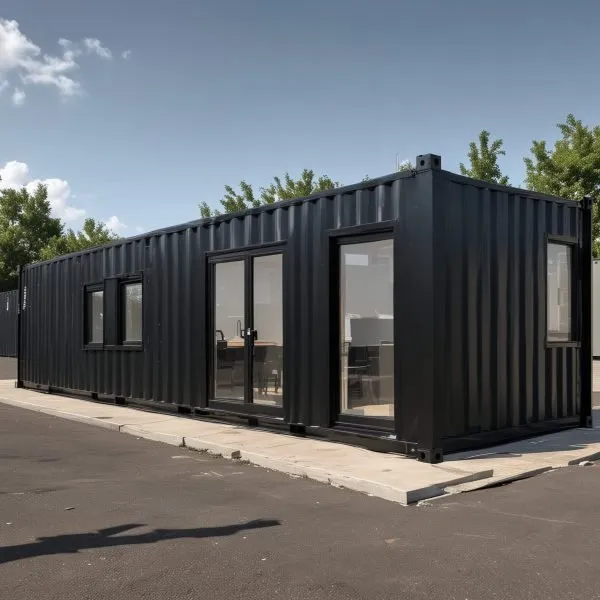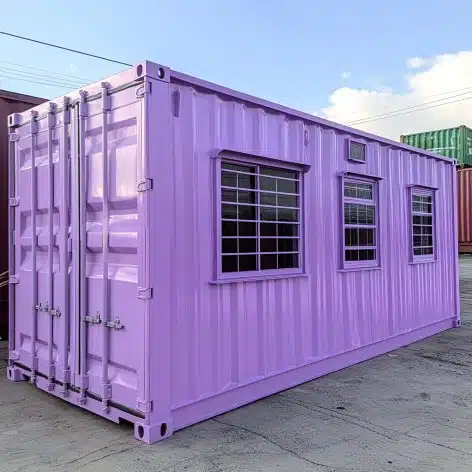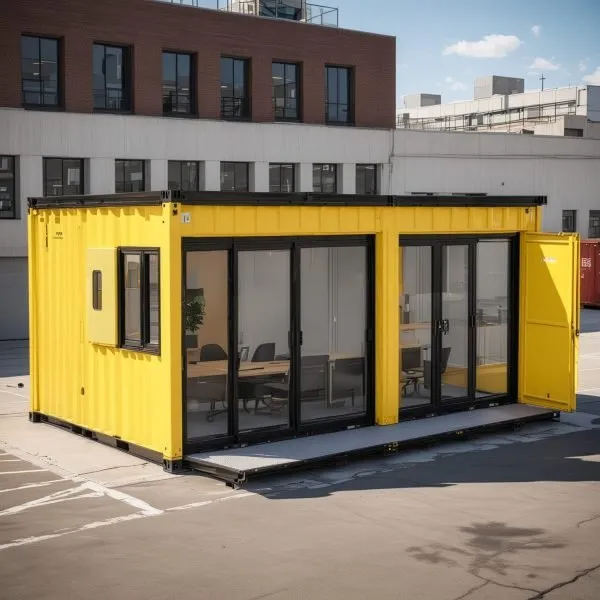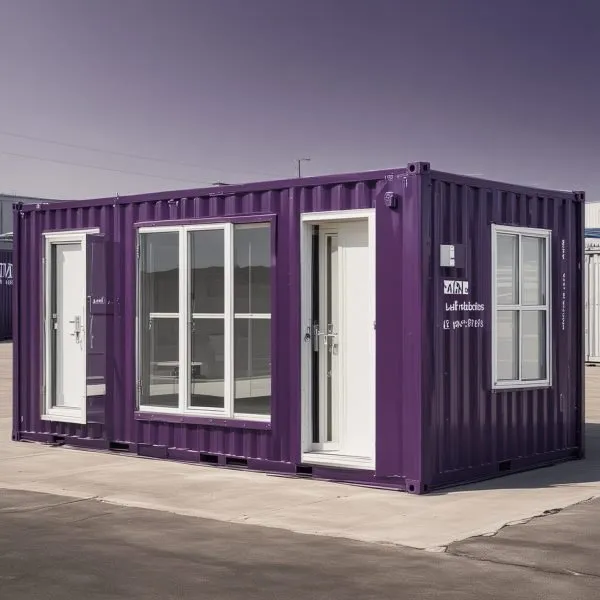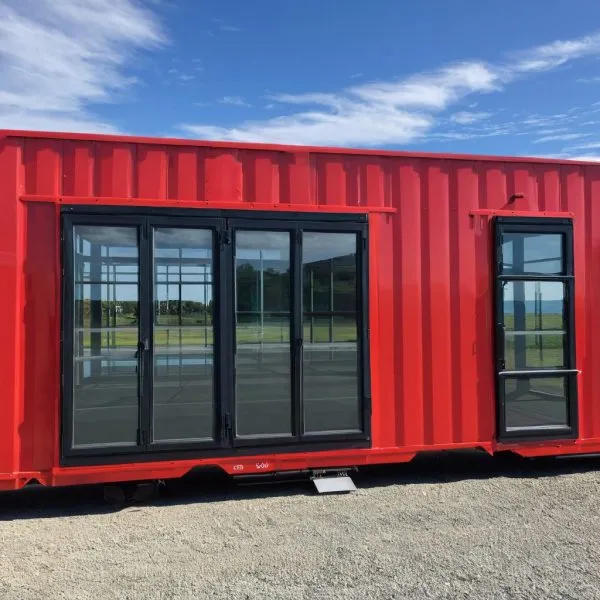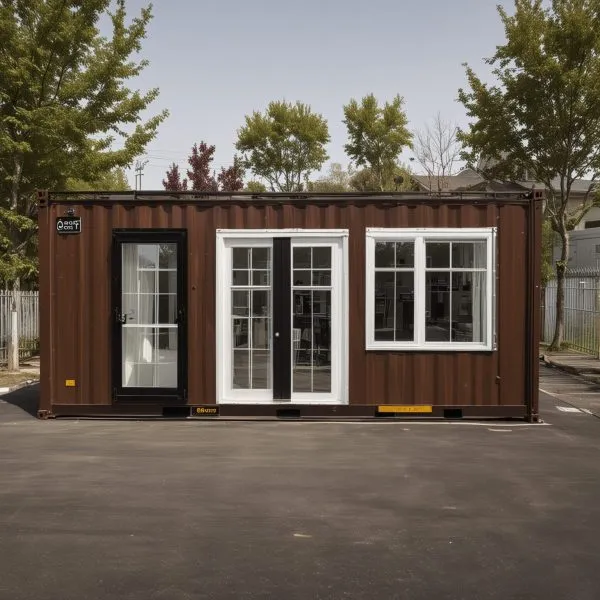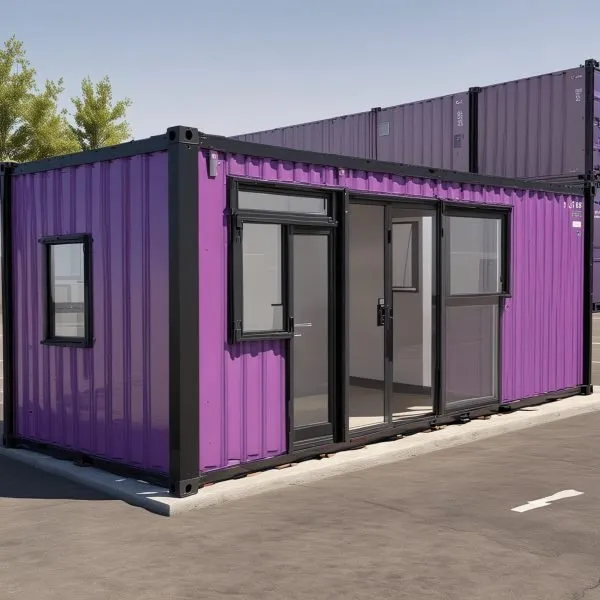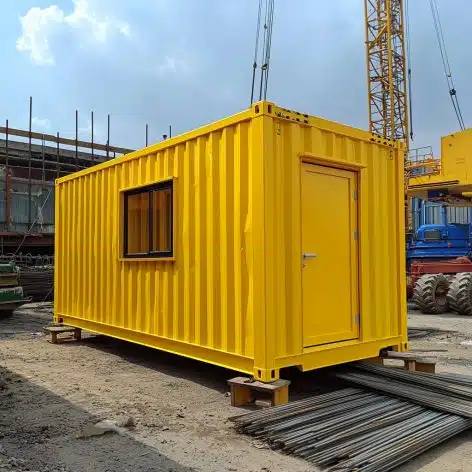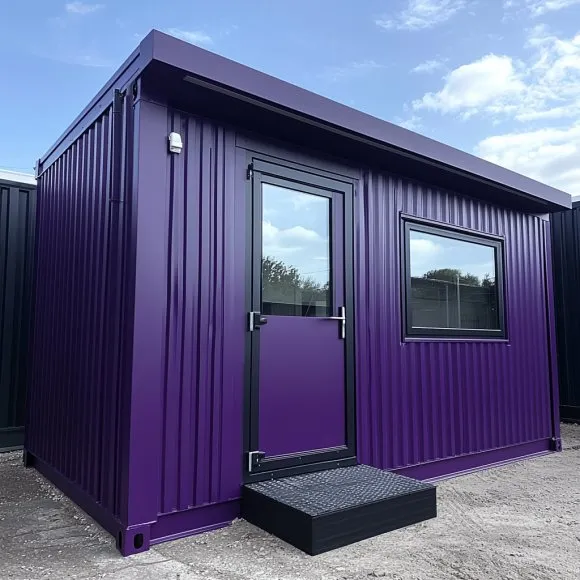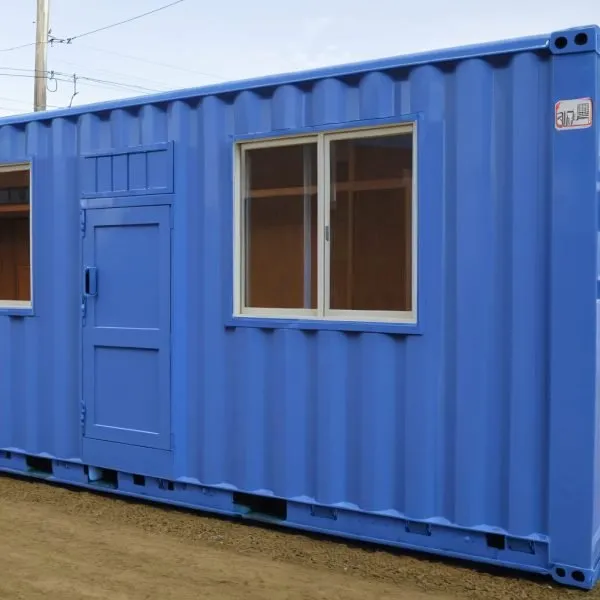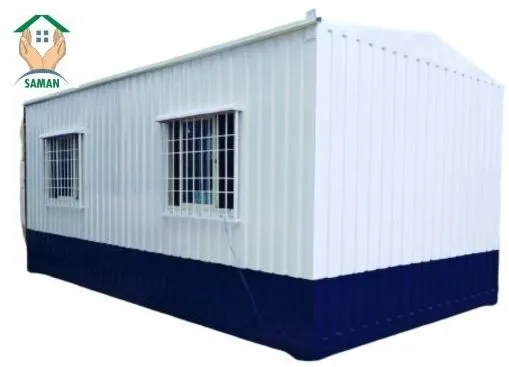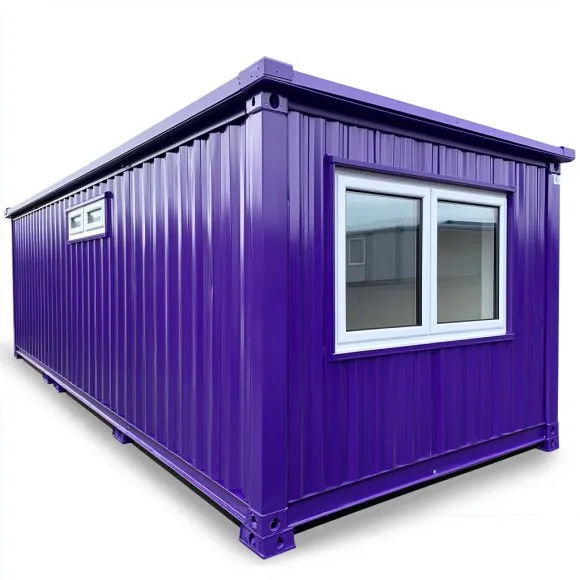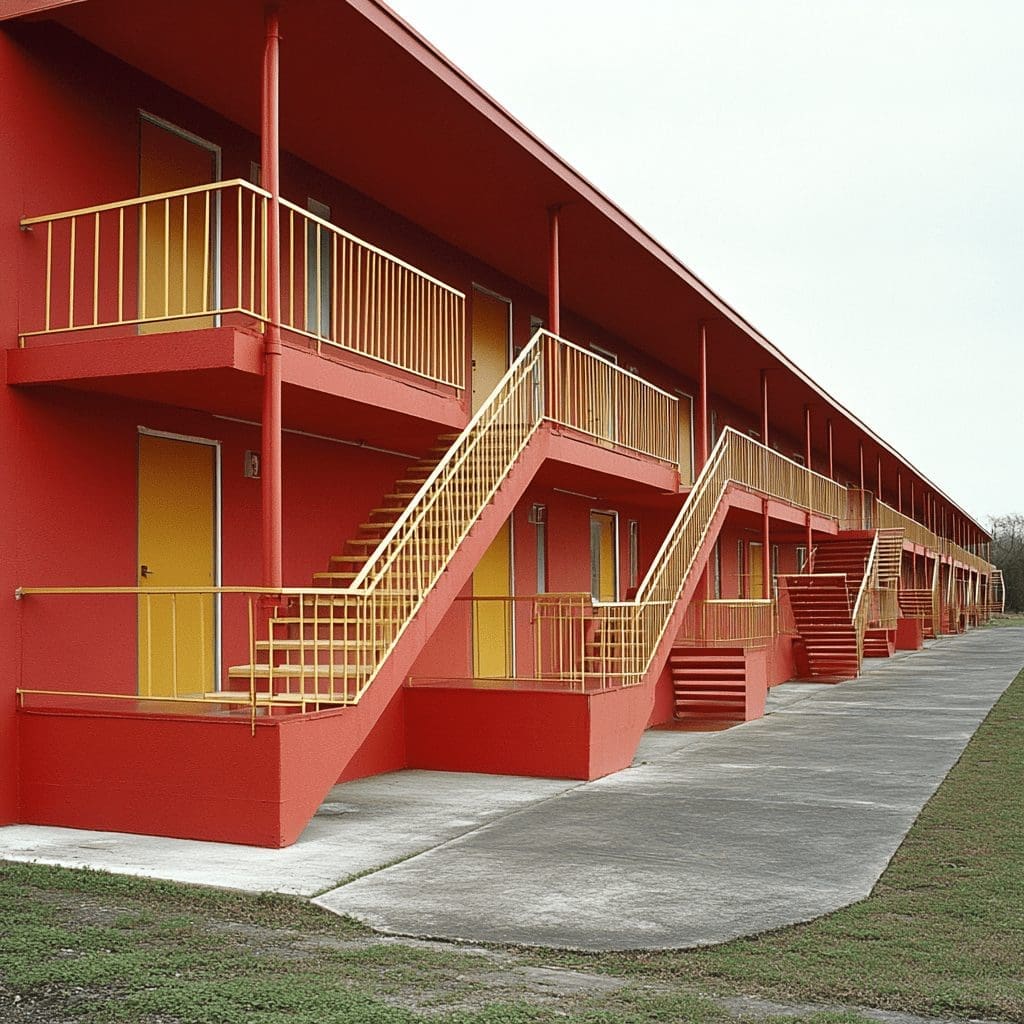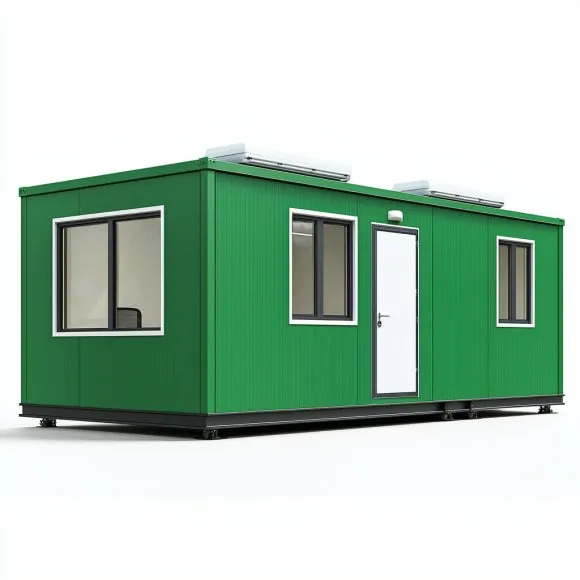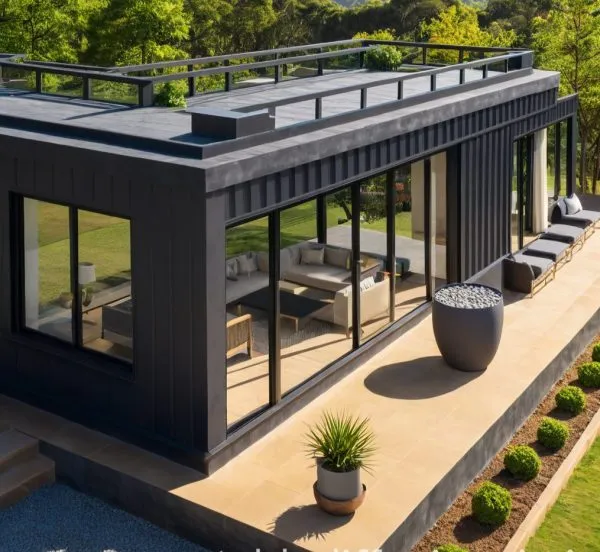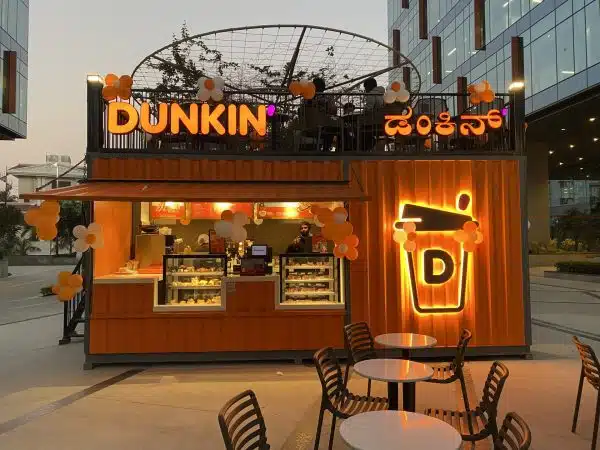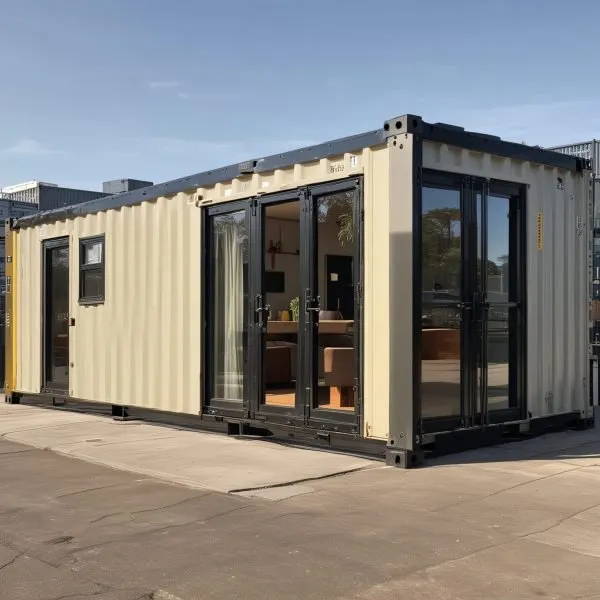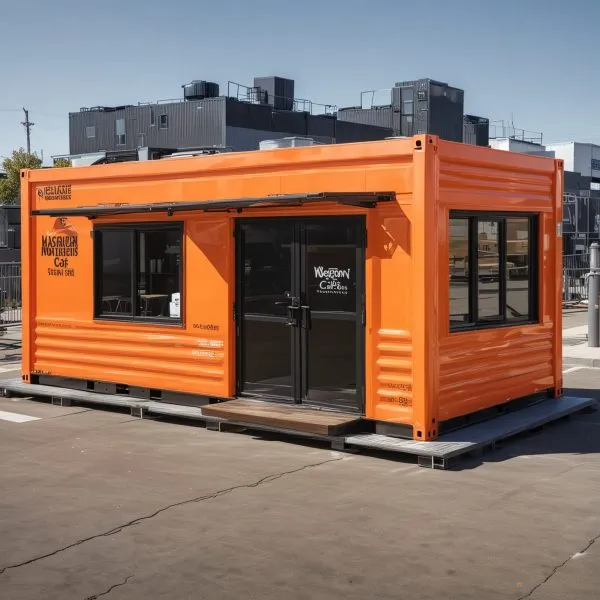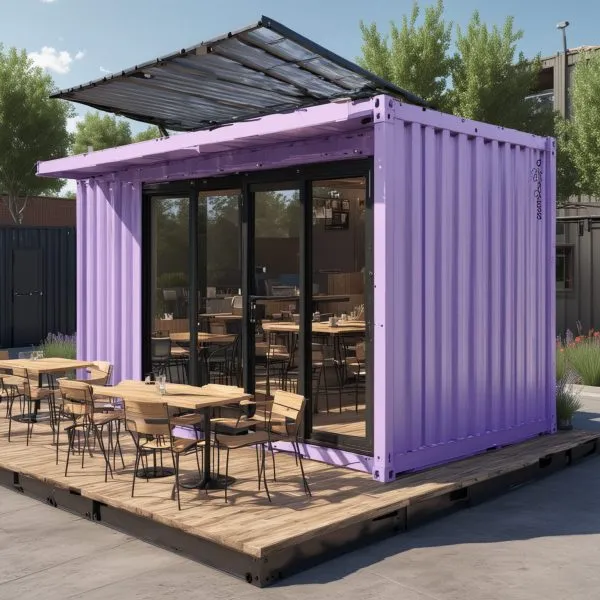Small Modular Porta Cabins: Compact Solutions for Modern Needs

Introduction to Small Modular Porta Cabins
In a world where space optimization is key, small modular porta cabins have become increasingly popular for both personal and professional use. These compact, versatile cabins offer a range of solutions, from tiny homes and site offices to guard rooms and storage spaces, providing functionality without requiring a large footprint. Designed to be both adaptable and durable, small cabins meet the needs of various industries, whether it’s a small cabin at a construction site or a portable workspace in a corporate setting.
One of the greatest advantages of these small cabins is their prefabricated nature, allowing for quick installation and minimal on-site assembly. Prefab cabins are manufactured in controlled environments, ensuring quality and consistency while reducing construction time. This makes them a cost-effective choice for businesses and individuals who need immediate, adaptable spaces. For example, businesses can install a prefab cabin as a temporary office or meeting room without committing to a permanent structure.
Furthermore, modern small cabin designs incorporate elements to maximize interior space and functionality, making them suitable even for complex needs. From strategic window placements to built-in storage solutions, these designs are tailored to make the most of every square foot. Many small cabins use durable materials like FRP cabins (Fiber Reinforced Plastic) that offer lightweight, corrosion-resistant properties, ensuring longevity even in outdoor or challenging environments.
For those seeking additional modular office options, container offices offer a larger scale alternative with similar benefits, while our portable cabins provide adaptable solutions across different spaces and industries. These cabins showcase how portable solutions can range in size and purpose, supporting diverse applications for modern needs.
Benefits of Small Prefabricated Cabins

Small prefabricated cabins, or small prefab cabins, offer an efficient, flexible, and cost-effective solution for a wide range of applications. Whether used as temporary offices, storage spaces, or compact living units, small cabins provide the adaptability and durability needed to support diverse environments. Here’s a look at the key benefits of choosing small modular cabins for your space needs.
1. Quick Installation and Minimal Site Disruption
One of the primary benefits of small prefab cabins is their quick installation. Because these cabins are prefabricated in controlled settings, they can be assembled on-site in a fraction of the time it would take to construct a traditional building. This streamlined setup minimizes site disruption, making small cabins ideal for locations that require rapid deployment, like construction sites or event venues.
2. Cost-Effective Alternative to Permanent Structures
Prefabricated cabins are significantly more affordable than permanent structures, making them accessible for businesses or individuals working within tight budgets. Since they are modular and reusable, small cabins can be relocated or reconfigured as needed, offering a budget-friendly solution for temporary or semi-permanent needs. Choosing a small cabin can save on both construction costs and long-term maintenance.
3. Durable and Low-Maintenance Design
Small cabins, especially those made from durable materials like FRP cabins (Fiber Reinforced Plastic), require minimal maintenance and provide long-lasting performance. FRP is corrosion-resistant, lightweight, and durable, making it an excellent choice for portable structures exposed to varying weather conditions. This durability reduces repair needs and ensures that the cabin remains in top shape over time, providing excellent value.
4. Eco-Friendly and Sustainable Option
For businesses and individuals looking to reduce their environmental footprint, small modular cabins are an eco-friendly choice. The prefabrication process reduces waste, and materials like FRP are recyclable, supporting green building practices. Additionally, the modular nature of small cabins allows them to be relocated and reused, reducing the need for new materials and lowering environmental impact.
5. Versatile Applications Across Industries
Small modular cabins are adaptable to a wide range of applications, from security booths and site offices to tiny homes and mobile clinics. Their compact design makes them suitable for tight spaces, and they can be customized with small cabin design ideas tailored to specific needs. For businesses requiring flexible office spaces, portable cabins offer similar modular benefits, meeting the demands of various industries.
By offering quick setup, affordability, and sustainability, small prefab cabins have become an indispensable choice for modern space solutions. For those interested in more extensive options, explore our range of container offices designed to cater to diverse needs, from industrial to commercial applications.
Common Uses of Small Cabins Across Industries
Small modular cabins have a wide range of applications, making them a practical and versatile solution for numerous industries. From providing temporary workspaces to serving as compact living units, small cabins meet the demands of diverse environments efficiently. Here’s a look at some common uses of small modular cabins and how they support various industries.
1. Site Offices for Construction Projects
Construction sites often require temporary offices for project managers, engineers, and site supervisors. Small cabins serve as efficient on-site offices, providing a comfortable workspace that includes seating, desks, and secure storage for documents and equipment. These cabins are easily movable, making them ideal for dynamic construction sites where needs frequently change.
2. Guard Rooms and Security Booths
Security personnel stationed at entry points or sensitive locations need a safe, functional space to monitor and manage access. Small prefab cabins are perfect for security booths, offering a comfortable workspace with visibility of the surrounding area. Many businesses choose FRP cabins for this purpose due to their lightweight yet durable construction, providing reliable shelter and protection for guards.
3. Tiny Homes and Compact Living Spaces
With the growing trend toward minimalism and sustainable living, small cabin designs are increasingly being used as tiny homes. These cabins can be customized with features like kitchenette setups, sleeping areas, and bathrooms, providing all the essentials in a compact, affordable footprint. The prefabricated nature of small cabins makes them easy to set up and relocate, making them a popular choice for alternative housing solutions.
4. Temporary Clinics and First Aid Stations
Industries requiring on-site medical facilities, such as construction or large-scale events, benefit from small cabins configured as first aid stations or temporary clinics. These cabins provide a controlled environment with space for medical supplies, examination areas, and seating for patients. Modular cabins can be easily adapted to meet basic healthcare needs, ensuring that quick medical assistance is accessible on-site.
5. Storage Units for Tools and Equipment
In industries where tools and equipment need secure, weather-resistant storage, small prefab cabins offer a practical solution. With options to customize interior shelving and secure locking mechanisms, these cabins serve as safe, compact storage units. They are frequently used in industries such as construction, landscaping, and event management, where access to essential tools is needed on demand.
6. Break Rooms and Employee Rest Areas
Employee comfort is essential, especially on remote sites. Small modular cabins can be set up as break rooms or rest areas, providing a place for staff to take breaks, store personal items, or relax during off-hours. With insulation and climate control options, these cabins ensure a comfortable environment, contributing to employee satisfaction and productivity.
7. Pop-Up Retail Shops and Kiosks
For businesses looking to expand their retail presence temporarily or during seasonal events, small cabins can be used as pop-up shops or kiosks. These cabins are easy to set up and provide a customizable space where businesses can display products, interact with customers, and create a unique shopping experience. Their portability allows retailers to move their pop-up shops as needed, adapting to different locations.
8. Temporary Classrooms and Training Spaces
Educational institutions and training centers can use small modular cabins as temporary classrooms or training spaces. These cabins can be equipped with seating, whiteboards, and AV equipment, providing a functional learning environment. They are particularly useful for institutions undergoing renovations or experiencing high enrollment and are a cost-effective way to expand learning spaces.
With such versatility, small cabins offer practical solutions across industries, catering to a wide array of needs while remaining efficient and adaptable. For organizations interested in larger modular setups, our portable cabins provide flexible options for various professional and industrial needs. To explore more ways modular cabins can serve your business, view our porta cabin options here.
Key Features of Small Cabin Designs

The design of small cabins maximizes functionality in a compact space, making them ideal for various applications. Whether they’re used as tiny homes, offices, or guard rooms, the unique features of small cabin designs enhance comfort, utility, and efficiency. Here’s a breakdown of the essential features that make small cabins an excellent choice for space-conscious users.
1. Space-Efficient Layouts
A hallmark of small cabin designs is their ability to maximize limited space. Clever layout strategies ensure that every square foot is used efficiently, often incorporating multi-purpose areas. For example, small cabins might include foldable tables, integrated storage, or compact seating arrangements to optimize space. This thoughtful design makes them highly functional, even in limited areas.
2. Built-In Storage Solutions
Storage is crucial in any small space, and small cabin design ideas often include built-in shelving, cabinets, and hidden compartments. These storage solutions keep the cabin organized and clutter-free, making them especially useful for workspaces, tiny homes, or security guard rooms. Efficient storage design ensures that occupants have ample space to store tools, equipment, or personal belongings without compromising the cabin’s open layout.
3. Durable Construction with FRP Options
Materials like Fiber Reinforced Plastic (FRP) are commonly used in small modular cabins due to their lightweight and durable properties. FRP cabins are highly resistant to corrosion, moisture, and UV damage, making them ideal for outdoor and industrial use. This material choice ensures the cabin can withstand harsh conditions while requiring minimal maintenance, which is essential for long-term applications in challenging environments.
4. Insulation and Climate Control
To ensure comfort in all weather conditions, many small cabins are equipped with insulation and climate control features like heating and air conditioning. Proper insulation regulates the cabin’s temperature, making it suitable for year-round use. This is especially beneficial for cabins used as workspaces or living quarters, as climate control enhances comfort and helps maintain a productive environment.
5. Customizable Interior and Exterior Finishes
Customizability is a key feature of small modular cabins, allowing users to personalize the cabin’s interior and exterior finishes. Options like vinyl flooring, wooden paneling, and custom paint colors enable cabin owners to match the design to their brand or personal style. Whether creating a professional look for an office cabin or a cozy atmosphere for a tiny home, customization ensures the cabin fits its purpose.
6. Large Windows for Natural Light
Natural light is essential for small spaces, making large windows a valuable feature in small cabin designs. Windows not only enhance the cabin’s aesthetics but also improve ventilation and create an open, airy feel. For security guard rooms or offices, strategically placed windows offer clear visibility of the surroundings, allowing occupants to monitor outdoor areas easily.
7. Modular and Stackable Design Options
For those requiring expandable solutions, small modular cabins can be designed with modular features, allowing them to connect or stack with other units. This versatility makes them suitable for growing needs, such as creating multi-room setups or temporary expansions. Modular designs offer the flexibility to adapt as requirements change, providing a scalable solution without major renovations.
8. Eco-Friendly Construction
Sustainability is increasingly important, and many small cabins are built with eco-friendly materials and practices. Options like FRP are not only durable but also recyclable, aligning with green building goals. Additionally, the prefabrication process reduces waste, and the modular design minimizes the environmental impact by avoiding large-scale construction.
These features make small modular cabins a practical choice for a variety of uses, offering durability, adaptability, and comfort. For more extensive options, explore our container offices and portable cabins that provide similar flexibility on a larger scale.
FRP Cabins: Lightweight and Durable Option
Fiber Reinforced Plastic (FRP) has become a preferred material for small modular cabins due to its remarkable durability and lightweight properties. As a material known for its corrosion resistance and low-maintenance qualities, FRP cabins are widely used across industries where long-lasting and resilient structures are essential. Here’s a closer look at why FRP is an ideal material for small prefab cabins and the benefits it brings to modular spaces.
1. High Corrosion Resistance
FRP is resistant to corrosion from chemicals, moisture, and UV exposure, making it an excellent choice for small cabins used in outdoor or industrial settings. Unlike metal cabins that may rust or wooden cabins that may warp, FRP cabins maintain their integrity even in harsh conditions. This corrosion resistance ensures that the cabin lasts longer and reduces the need for repairs or replacements over time.
2. Lightweight and Easy to Transport
One of the major advantages of FRP cabins is their lightweight nature. FRP is significantly lighter than steel or concrete, making these cabins easy to transport and relocate as needed. This lightweight feature allows for quick installations, as they can be moved to different sites without heavy machinery or extensive labor. For businesses needing flexibility in workspace placement, FRP cabins provide a hassle-free solution.
3. Low Maintenance Requirements
FRP is a low-maintenance material that requires minimal upkeep. It doesn’t require frequent painting, sanding, or repairs, making it a cost-effective option over the cabin’s lifespan. FRP cabins resist common issues like rust, rot, and insect damage, which are typical concerns for metal or wooden structures. This quality makes FRP an ideal choice for businesses or individuals seeking a low-maintenance, durable small cabin.
4. Strong and Impact-Resistant Construction
Despite being lightweight, FRP cabins are exceptionally strong and impact-resistant. FRP has a high strength-to-weight ratio, providing robustness that withstands heavy use and occasional impacts. This feature makes FRP cabins suitable for industrial sites, remote areas, and locations with rough handling, as they can withstand wear and tear without compromising their structure.
5. Thermal and Electrical Insulation Properties
FRP is known for its insulating properties, providing good thermal and electrical insulation, which enhances safety and comfort within the cabin. For small cabin designs intended as workspaces, guard rooms, or storage units, these insulating qualities contribute to a more comfortable and secure environment. Thermal insulation helps regulate indoor temperatures, while electrical insulation minimizes risks in areas where electrical equipment is used.
6. Eco-Friendly and Sustainable Option
As a recyclable material, FRP aligns with sustainable building practices. Its durability reduces the need for frequent replacements, lowering waste over time. Additionally, FRP cabins can be reused and repurposed, supporting eco-friendly practices. For businesses prioritizing sustainability, FRP cabins provide an environmentally responsible alternative to traditional building materials.
7. Customization with Various Finishes
FRP cabins can be customized with different finishes to match the aesthetic or functional requirements of any application. From smooth surfaces to textured finishes, FRP small cabins can be designed with interiors and exteriors that suit their specific use. These customizations provide flexibility in appearance, making FRP cabins suitable for various commercial and industrial environments.
By offering strength, flexibility, and low maintenance, FRP cabins are a smart choice for businesses and individuals looking for a long-lasting and portable cabin solution. For those interested in additional modular options, explore our versatile portable cabin solutions here, designed to meet diverse needs across industries.
Small Cabin Design Ideas for Efficient Space Use
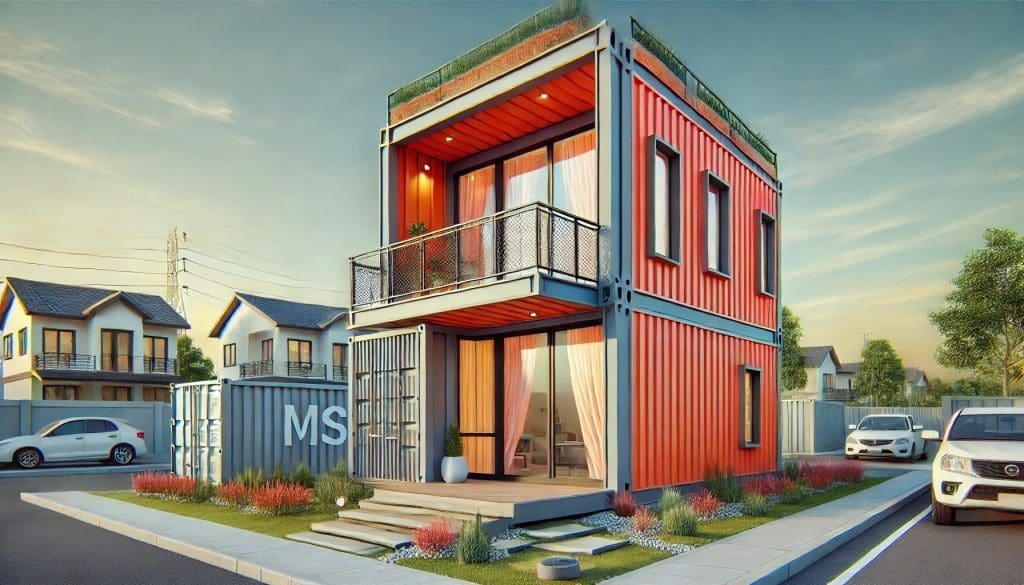
Designing an efficient small cabin requires strategic planning to maximize limited space while maintaining functionality and comfort. Whether intended as an office, guard room, or living space, incorporating practical small cabin design ideas can create a more organized, spacious, and productive environment. Here are some top design ideas to make the most of your small cabin layout.
1. Open Floor Plans for Enhanced Flow
An open floor plan can make a small cabin feel larger by eliminating unnecessary walls and partitions. Open layouts are ideal for offices or guard rooms where flexibility is essential, providing a versatile space that can accommodate seating, desks, or storage units without feeling cramped. By keeping the floor plan open, you create a more adaptable and visually spacious cabin.
2. Multi-Functional Furniture
Using multi-functional furniture is one of the most effective ways to save space in a small cabin. Foldable desks, convertible seating, and stackable chairs maximize usable space and ensure flexibility. For example, a fold-out desk can serve as a workspace during the day and be tucked away when not in use, freeing up floor space for other activities.
3. Built-In Storage Solutions
Built-in storage helps keep a small cabin organized and clutter-free. Wall-mounted shelves, cabinets, and hidden compartments can provide ample storage without taking up valuable floor space. Incorporating storage into walls and under seating creates a tidy and efficient environment, making built-in storage essential for small cabin designs used as workspaces or personal quarters.
4. Large Windows for Natural Light
Natural light can make a small space feel more open and inviting. Installing large windows in a small modular cabin brightens the interior and provides ventilation, improving comfort for occupants. For security cabins or workspaces, windows offer clear visibility to the outside, enhancing functionality. Additionally, natural light minimizes the need for artificial lighting, saving energy and reducing costs.
5. Vertical Space Utilization
Using vertical space is key in small cabin designs. Installing shelving, hooks, or wall-mounted storage units allows you to store items without occupying floor space. For guard rooms or storage cabins, vertical storage helps keep essential items within reach while freeing up the main area, creating a neat and functional setup.
6. Compact Kitchenette or Utility Area
In cabins used as temporary housing or extended workspaces, a compact kitchenette or utility area provides convenience without occupying much room. Small cabins can be fitted with mini fridges, microwaves, or sinks, creating a comfortable setting for occupants who may need to prepare meals or snacks. For break rooms or remote sites, this feature adds practical value to the cabin.
7. Lightweight, Flexible Materials
Incorporating lightweight and flexible materials, such as FRP (Fiber Reinforced Plastic), allows for easy modification and minimal maintenance. FRP cabins are ideal for outdoor or industrial use due to their durability, and their lightweight nature makes it easier to integrate modular elements, such as movable dividers or lightweight furniture, that adapt to changing needs.
8. Modular and Stackable Designs
For growing needs, modular and stackable designs offer flexibility by allowing multiple small cabins to connect or stack as required. This is particularly beneficial for workspaces or residential units where additional space may be needed over time. Modular cabins can expand vertically or horizontally, providing a scalable solution that grows with the occupant’s requirements.
9. Minimalist and Clutter-Free Aesthetic
A minimalist design with fewer decorative items creates a clean and open feel in a small cabin. Focusing on essential furnishings and avoiding excessive decor helps maintain a clutter-free space. This approach is especially effective in small office cabins or guard rooms, where simplicity supports productivity and clear movement within the cabin.
10. Exterior Customization to Enhance Aesthetics
While focusing on interior space is crucial, the cabin’s exterior design also matters. Customizable finishes, colors, and textures allow owners to align the exterior look with their branding or aesthetic preferences. Attractive exterior designs not only improve visual appeal but also create a cohesive look when small modular cabins are used within a larger facility.
Incorporating these design ideas transforms small modular cabins into efficient, comfortable, and functional spaces. Whether used as offices, tiny homes, or guard cabins, these design strategies help make the most of limited space. For more options in versatile modular cabins, explore our full range of porta cabins here, tailored for a variety of applications and environments.
Customization Options for Small Prefab Cabins
One of the primary benefits of small prefab cabins is the high degree of customization they offer. Customizable features allow these compact spaces to meet specific needs, from security requirements and personal comfort to professional functionality. Here’s a look at some of the top customization options available for small modular cabins, making them adaptable for any setting.
1. Interior Layout Configurations
Custom interior layouts allow users to optimize the available space based on their specific needs. Whether you require a single open room, partitioned areas, or a built-in seating arrangement, customized layouts make small cabins versatile and functional. For example, a small cabin used as an office might benefit from a partitioned workspace, while a guard room could have a layout that emphasizes visibility and accessibility.
2. Climate Control and Insulation
For comfortable year-round use, small prefab cabins can be fitted with climate control options such as air conditioning, heating, and insulation. Proper insulation keeps the cabin cool in summer and warm in winter, enhancing comfort for users who spend extended periods inside. This is especially useful for guard cabins or remote offices where personnel require a stable environment.
3. Enhanced Security Features
Security is crucial for small cabins used in high-risk or industrial settings. Customization options like reinforced doors, lockable windows, and shatterproof glass ensure that the cabin remains secure. Many security cabin manufacturers also offer advanced options such as CCTV camera integration and alarm systems to enhance the safety of both the cabin and its occupants.
4. Built-In Furniture and Storage Solutions
Small cabins can be customized with built-in furniture and storage solutions to maximize space and organization. Options include wall-mounted shelves, cabinets, desks, and foldable seating that adapt to the cabin’s compact layout. For small cabin designs used as workspaces or living spaces, these built-in features keep the interior neat, efficient, and functional.
5. FRP Material Customization
Fiber Reinforced Plastic (FRP) is a popular choice for small modular cabins due to its durability and lightweight nature. FRP cabins offer customization in finishes, colors, and textures, allowing users to match the cabin’s look to the surrounding environment or branding needs. FRP’s resilience to harsh weather and corrosion makes it ideal for cabins used in outdoor or industrial settings.
6. Exterior Finishes and Branding
The exterior of a small cabin can be customized with various finishes and colors to enhance its visual appeal or align with branding. Whether it’s a sleek, professional look for an office or a rugged finish for a construction site cabin, custom exterior finishes make small cabins blend seamlessly into any setting. Branding elements, such as company logos and color schemes, add a professional touch to cabins used in corporate environments.
7. Modular Expansion Options
For projects with evolving space needs, modular cabins offer expansion options, allowing users to connect or stack multiple units. This flexibility means that a small cabin can serve as a standalone unit or become part of a larger modular structure as space requirements grow. Modular expansion is ideal for companies needing flexibility, such as adding offices, storage rooms, or break areas over time.
8. Electrical and Communication Outlets
Built-in electrical and communication outlets make small cabins suitable for professional and technical uses. Outlets for lighting, equipment, and communication devices allow for a well-connected workspace, enabling guards, office staff, or residents to access power and communication seamlessly. These customizations are especially valuable for cabins used as on-site offices or remote monitoring stations.
9. Window and Ventilation Customization
Customized window placements and ventilation options ensure the cabin has adequate airflow and visibility. For small cabin designs used as guard rooms or workspaces, large windows provide clear sightlines for monitoring surroundings. Ventilation options like exhaust fans and additional vents keep the cabin comfortable and reduce heat buildup, particularly in warmer climates.
10. Bathroom and Kitchenette Additions
For users needing extended use or remote housing options, small cabins can be fitted with compact bathroom or kitchenette facilities. These amenities make small cabins viable as temporary housing, break rooms, or even tiny homes. Compact sinks, mini refrigerators, and portable toilets are practical solutions that add significant value for users needing self-contained facilities.
Customizable small prefab cabins provide users with a versatile and tailored solution for various applications, from professional workspaces to cozy personal spaces. For a broader look at customizable modular solutions, view our selection of portable cabins here, designed to meet diverse needs across different environments.
Comparing Small Cabins to Larger Modular Options

When deciding between a small cabin and a larger modular unit, it’s essential to consider your space requirements, budget, and intended use. Small cabins offer compact, cost-effective solutions, while larger modular options provide more space and flexibility. Here’s a comparison of small modular cabins and larger modular units to help you determine which option best fits your needs.
1. Space Efficiency and Functionality
Small cabins are designed to make the most of limited space, focusing on efficient layouts and compact furniture. They are ideal for applications where minimal space is needed, such as guard rooms, break areas, or compact office setups. In contrast, larger modular units provide additional room for more complex layouts, accommodating multiple workstations, meeting rooms, or living quarters.
2. Cost Considerations
Small cabins are typically more budget-friendly than larger modular options, as they require fewer materials and less labor. For businesses or individuals looking to optimize costs, small prefab cabins provide a cost-effective way to establish a functional workspace or living area. Larger modular units, though more expensive, offer better value for projects that require extensive space or additional amenities, like multi-room setups.
3. Portability and Flexibility
One of the main advantages of small modular cabins is their portability. Lightweight and easy to transport, small cabins can be relocated frequently, making them suitable for construction sites or temporary events. Larger modular structures may require additional equipment for transportation, making them ideal for semi-permanent setups where frequent relocation is not needed.
4. Setup and Installation
Small cabins generally have a quicker setup time, as they require less preparation and assembly. This makes them ideal for projects with tight deadlines or situations that require rapid deployment. Larger modular units take more time and resources to set up, as they may include multiple sections or require additional fixtures, such as plumbing and electrical work.
5. Customization Options
Both small and large modular units offer customization options, though larger units provide more extensive possibilities due to their size. Small cabin designs can include built-in storage, compact workstations, and basic amenities. Larger modular options, however, allow for full customization with options for partitioned rooms, bathrooms, kitchens, and more elaborate interior layouts.
6. Ideal Applications
Small cabins are commonly used for applications that require compact, single-room solutions, such as security booths, small office spaces, or temporary living quarters. Larger modular units are well-suited for applications that demand multiple rooms or extended work areas, such as office complexes, multi-room housing units, or classrooms.
7. Energy Efficiency and Maintenance
Smaller cabins generally have lower energy consumption, making them easier and cheaper to heat, cool, and maintain. Larger modular units, while offering more space, may have higher energy demands, especially if climate control is required across multiple rooms. However, both types can be equipped with energy-efficient features to reduce long-term operational costs.
8. Structural Durability and Material Choices
Both small and large modular cabins can be built with durable materials like FRP cabins (Fiber Reinforced Plastic) for corrosion resistance and lightweight strength. However, larger structures often require reinforced frameworks to support additional sections and weight. Choosing durable materials, regardless of size, ensures longevity and minimizes maintenance.
9. Expansion Possibilities
One advantage of modular construction is the ability to expand the structure over time. For example, small modular cabins can serve as the foundation of a larger complex by connecting additional units. Larger modular options offer built-in scalability, with many designs allowing for vertical or horizontal expansion.
10. Environmental Impact and Sustainability
Both small and large modular units are eco-friendly choices, as they use prefabricated construction methods that minimize waste. However, small prefab cabins generally have a smaller environmental footprint due to their compact size and efficient energy use. Larger modular units, though more resource-intensive, provide long-term sustainability by serving multi-functional roles that reduce the need for new construction.
By weighing these factors, businesses and individuals can select a modular cabin that aligns with their operational needs and budget. For those needing a compact, adaptable space, small cabins are a practical choice, while larger modular units offer extended flexibility for more complex requirements. To explore various modular cabin solutions that fit your project needs, view our range of porta cabins here.
Cost Factors of Small Modular and Prefab Cabins
When investing in a small modular or prefab cabin, understanding the cost structure helps in budgeting and choosing features that align with both needs and financial goals. Several factors influence the price of small cabins, from materials and size to customization options. Here’s a breakdown of the primary cost considerations when purchasing small modular cabins.
1. Size and Dimensions
The size of the cabin is a key determinant of cost. Smaller cabins are generally more affordable due to lower material and labor requirements. However, while compact small cabins save on costs, they may have limitations on interior space. Custom sizing or expansions, such as adding storage areas or partitions, may increase the overall expense.
2. Material Choices
Materials play a significant role in the pricing of small modular cabins. Options like FRP (Fiber Reinforced Plastic) are popular for their durability and low maintenance, though they may come at a premium. FRP cabins are often ideal for outdoor use due to their resistance to corrosion and weathering, providing excellent long-term value despite higher upfront costs. Other materials, like wood or basic metal, may be more affordable but may require more maintenance over time.
3. Customization and Additional Features
Customization options, including interior layouts, built-in furniture, climate control, and reinforced security features, can increase costs but improve cabin functionality and comfort. For instance, adding climate control systems or partitioned sections transforms a basic small prefab cabin into a more comfortable workspace or living area. While customization adds to the cost, it ensures that the cabin aligns precisely with specific needs.
4. Insulation and Climate Control
In regions with temperature extremes, insulation and climate control features are essential. Insulation helps regulate the cabin’s temperature, making it more comfortable for occupants and reducing energy costs. Adding features like air conditioning, heating, and insulated walls increases the price but is invaluable for small cabin designs used year-round.
5. Delivery and Installation
The logistics of delivering and installing a small prefab cabin also impact the final cost. For locations that are remote or challenging to access, transportation fees may be higher. Additionally, some manufacturers offer installation services as part of the package, while others charge separately. Clarifying these details upfront helps avoid unexpected expenses.
6. Security Enhancements
For cabins used in high-risk or sensitive areas, security enhancements such as reinforced doors, lockable windows, and shatterproof glass can add to the cabin’s cost. However, these features provide peace of mind, especially for small cabins used as guard rooms, storage units, or workspaces in vulnerable settings. Enhanced security is a worthwhile investment for businesses needing to protect assets and personnel.
7. Electrical and Communication Outlets
Electrical wiring, outlets, lighting, and communication systems, such as Wi-Fi or intercom connections, are additional costs that make the cabin functional as an office or technical space. These installations are essential for cabins used as workspaces or monitoring stations, adding value by creating a well-connected environment.
8. Exterior Finishes and Branding
Aesthetic customization for the cabin’s exterior, including paint, textures, or branding elements, can also impact costs. For businesses using small cabins in visible areas, branded finishes enhance professional appearance and brand consistency. These exterior finishes create a cohesive look that aligns with a company’s identity, adding visual appeal without significant expense.
9. Maintenance and Warranty Services
Some security cabin manufacturers offer maintenance and warranty options as part of the purchase package, which may add to the upfront cost but reduces potential repair expenses. Warranties covering materials, construction, and essential components provide protection against defects, making this a cost-effective choice in the long run.
10. Regulatory Compliance and Quality Standards
For industries with strict regulatory requirements, ensuring that the cabin complies with safety and quality standards can influence cost. Cabins that meet industry certifications, such as fire resistance, structural stability, and emergency exits, may be more expensive but offer added security and long-term value. These certifications ensure that the small cabin is fit for its intended purpose and safe for its occupants.
Understanding these cost factors allows buyers to make informed decisions, balancing budget and functionality when selecting small modular cabins. By choosing a cabin tailored to specific needs, businesses and individuals can maximize their investment while enjoying the benefits of a versatile, durable, and adaptable space. For cost-effective modular cabin solutions, explore our range of porta cabins here designed to suit a variety of applications.
Installation and Maintenance Tips for Small Cabins

Proper installation and regular maintenance of small modular cabins are essential to ensure they remain durable, functional, and safe over time. By following a few simple practices, businesses and individuals can maximize the longevity and usability of their small prefab cabins. Here are some installation and maintenance tips to help you get the most out of your small cabin.
1. Choose the Right Location for Installation
When installing a small cabin, selecting a stable, level surface is crucial to ensure safety and prevent structural issues. A flat, sturdy foundation reduces the risk of shifting or settling, which can damage the cabin’s structure over time. For outdoor cabins, avoid areas prone to flooding or erosion, and consider elevating the cabin slightly to improve water drainage.
2. Secure Proper Anchoring
For cabins installed in areas with strong winds or heavy foot traffic, secure anchoring is essential. Anchoring the cabin to the ground prevents it from shifting or tipping in adverse conditions. Some small modular cabins come with pre-built anchor points, and professional installation teams can ensure secure anchoring suited to the specific environment.
3. Regular Cleaning of Interior and Exterior
To maintain a clean and welcoming environment, regularly clean both the interior and exterior surfaces. For FRP cabins, use mild detergents and non-abrasive cleaning tools to avoid scratching the surface. Regular cleaning not only maintains the cabin’s appearance but also prevents dirt and debris from causing wear over time, especially in outdoor settings.
4. Inspect Structural Components Periodically
Routine inspections are essential for identifying potential issues early. Check the walls, roof, doors, and windows for any signs of cracks, rust, or water damage. By addressing these issues promptly, you can avoid more extensive repairs and ensure the cabin remains structurally sound. For small cabins used in demanding environments, such as construction sites, frequent inspections are recommended.
5. Maintain Climate Control and Insulation Systems
If your small cabin is equipped with climate control or insulation, regularly check these systems to ensure they’re functioning properly. Clean air filters, inspect insulation for damage, and test heating and cooling units to maintain a comfortable indoor environment. Well-maintained climate control systems are especially beneficial in cabins used as workspaces or extended-stay accommodations.
6. Lubricate Doors, Windows, and Hinges
Doors and windows in small cabins can become stiff over time, especially if the cabin is exposed to outdoor elements. Apply a lubricant to hinges, locks, and window latches to keep them operating smoothly. This small maintenance step prevents rusting and prolongs the lifespan of these components, ensuring that doors and windows remain functional and secure.
7. Check for Moisture and Water Leaks
Water damage can compromise the cabin’s structural integrity and lead to mold growth. Inspect the roof, walls, and flooring for any signs of moisture, particularly after heavy rain. Seal any visible gaps or cracks, and ensure that the roof is well-maintained to prevent leaks. For small modular cabins in wet climates, consider additional waterproofing to protect against moisture.
8. Test Electrical and Lighting Systems
If your small cabin includes electrical outlets, lighting, or communication systems, perform regular tests to ensure they are in working order. Replace any damaged wires or bulbs as necessary and monitor for any signs of electrical faults. Regularly checking electrical components prevents potential hazards and ensures a safe environment for occupants.
9. Seasonal Maintenance Adjustments
Different weather conditions require specific maintenance routines. For example, in winter, keep the roof clear of snow to prevent excess weight, and in summer, ensure ventilation systems are functioning to prevent heat buildup. Seasonal maintenance helps prepare the small cabin for changing conditions and ensures it remains comfortable for occupants year-round.
10. Apply Protective Coatings for Exterior Durability
To protect the exterior of the cabin, consider applying protective coatings that guard against UV exposure, rust, and wear. These coatings are especially beneficial for FRP cabins and other cabins exposed to outdoor elements. By applying protective coatings, you extend the life of the cabin’s exterior and maintain a polished appearance.
By following these installation and maintenance tips, owners of small modular cabins can enjoy a safe, comfortable, and long-lasting structure. For high-quality modular solutions designed for durability and ease of maintenance, explore our selection of customizable porta cabins here, tailored to meet diverse needs across various environments.
Conclusion: The Versatility and Value of Small Modular Cabins
Small modular cabins provide a flexible, efficient, and cost-effective solution for a wide range of applications, from temporary workspaces to compact living quarters. With the ability to customize these cabins for specific needs, businesses and individuals can create tailored, functional spaces that adapt to their requirements. Thanks to the durability of materials like FRP cabins and the variety of customization options available, small cabins are built to last, offering both quality and value.
From site offices and guard rooms to tiny homes and storage units, small prefab cabins are a practical choice for industries and individuals alike. Their ease of installation, minimal maintenance requirements, and adaptability make them an ideal investment, particularly in settings where space is limited, or flexibility is essential. For businesses looking for larger options, our portable cabin solutions provide similar modular benefits on a broader scale, allowing for scalability and expansion.
If you’re interested in exploring adaptable, durable, and customizable cabin options that meet your specific needs, view our full range of modular cabins and solutions designed to serve diverse applications across various industries. For more insights into our mission and approach, learn more about us here.
 Container Cafe
Container Cafe

